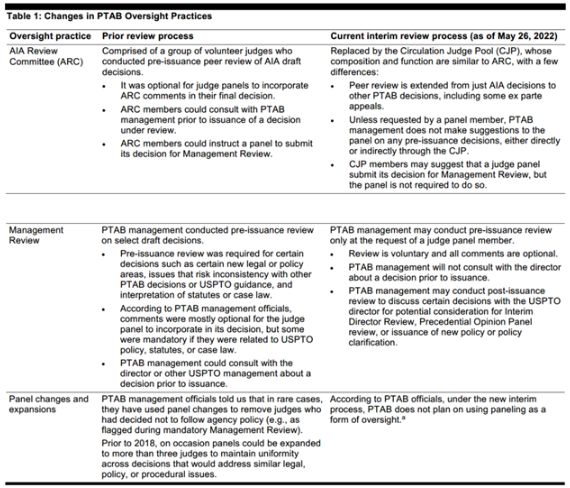In late 2022, the United States Government Accountability Office ("GAO") released its comprehensive study on transparency in the oversight of judicial decision-making at the U.S. Patent and Trademark Office's ("USPTO") Patent Trial and Appeal Board ("PTAB"). The report-titled "Increased Transparency Needed in Oversight of Judicial Decision-Making"1-provided Congress and the USPTO Director and PTAB management with several recommendations to ensure greater transparency in the oversight process to stakeholders and patent judges in America Invents Act ("AIA") proceedings.
Congress tasked GAO with examining PTAB oversight practices for decision-making, patent judges' perspectives on the effect of the oversight practices on their decisions, and stakeholders' and patent judges' perspectives on the external transparency of oversight practices. To assemble its report, GAO conducted interviews and surveys in early 2022, including:
- interviewing Director Kathi Vidal, PTAB management officials-including the Chief Judge, Deputy Chief Judge, five vice chief judges, two senior lead judges, and lead judges-as well as 12 non-management judges;
- interviewing 23 stakeholders, such as patent owners, petitioners, patent applicants, professional associations, IP experts, and former PTAB judges and management officials; and
- surveying all 234 non-management patent judges, of which 87% responded.
GAO found that 75% of the responding judges perceived PTAB management's oversight practices had some effect on their independence. Additionally, most interviewed stakeholders perceived a lack of transparency in the PTAB decision-making process, and some were unaware of PTAB management's involvement in the process.
GAO's report provided four recommendations to the USPTO Director and PTAB management to increase transparency in to USPTO's oversight practices:
- Clarify finalized policies for all internal review processes, specifically the role of the Director or PTAB management in the processes, the identity of the reviewer, whether the reviewers' changes were mandatory or optional, and the effect of following or not following the comments on a judge's performance review.
- Improve internal communications to advance transparency by communicating policies and expectations directly to judges; providing written and verbal communication for desired changes; and creating a PTAB intra-net containing all up-to-date policies, directives, changes, and announcements.
- Improve communication with stakeholders regarding PTAB oversight processes, including publishing policies, directives, or guidance that judges must follow which may have a substantive effect on their decision-making.
- Publish external Precedential Opinion Panel ("POP") guidelines for stakeholders that outline when and how to provide feedback for on POP decisions.
In response to the report, USPTO agreed with GAO's recommendations. Additionally, USPTO explained that it had already begun to address some of the recommendations when it issued interim oversight practices in May 2022,2and issued a Request for Comment to stakeholders on the same in July 2022.3The new interim oversight practices were USPTO's direct response to the Supreme Court's Arthrex decision which ensures that the Director holds the ultimate authority of the agency,4and she can "review final PTAB decisions and issue decisions" on her own.5
When USPTO published the interim oversight changes, it gave outside stakeholders their first look at PTAB's old and new oversight mechanisms. A comparison of the previous and interim oversight practices is provided below:

Source: GAO analysis of PTAB information (GAO-23-105336).
Judge panels may now ask for PTAB management review before issuing decisions, in stark contrast to the required review which existed before. Additionally, PTAB management will no longer consult the Director prior to issuance of a decision. GAO's report described the changes implemented in the USPTO's interim oversight practices as a "good first step to address the concerns" judges and stakeholders expressed, and GAO plans to support the USPTO's plan to institutionalize more transparency to PTAB oversight through formal rulemaking.
While it may be too soon to determine what effect publicly disclosing its review processes will have on PTAB practice or the district court cases that rely on their findings, stakeholders might find such insight beneficial when determining to go forward at PTAB.6
Only time will tell if USPTO will follow GAO's recommendations for increasing transparency in the oversight of PTAB judicial decision-making, but it has already begun to provide more clarity on the processes and expectations for review to patent judges and stakeholders.
Footnotes
1 Available at U.S. Gov't Accountability Office, GAO-23-105336, Patent Trial & Appeal Board: Increased Transparency Needed in Oversight of Judicial Decision-Making (Dec. 2022), https://www.gao.gov/assets/gao-23-105336.pdf.
2 See USPTO, Interim process for PTAB decision circulation and internal PTAB review, https://www.uspto.gov/interim-process-ptab-decision-circulation-and-internal-ptab-review?utm_campaign=subscriptioncenter&utm_content=&utm_medium=email&utm_name=&utm_source=govdelivery&utm_term= (last visited Feb. 7, 2023).
3 See Request for Comments on Director Review, Precedential Opinion Panel Review, and Internal Circulation and Review of Patent Trial and Appeal Board Decisions, 87 Fed. Reg. 43,249 (Jul. 19, 2022).
4 See U.S. v. Arthrex, Inc., 594 U.S. ___, 18 (2021).
5 See Letter from Jeremy Pelter, Acting Chief Fin. Officer & Asst. Sec'y Admin, U.S. Dep't of Comm, to Candice Wright, Dir., Sci. Tech. Assessment & Analytics, U.S. GAO (Dec. 12, 2022), reprinted in GAO, supra note 1, app. IV, at 78.
6 Director Vidal's changes to procedures at PTAB may very well raise its popularity as a venue for patent disputes. See Amara Osisioma, Vidal's Tenure May Make the PTAB a More Desirable Litigation Venue, Baker Botts: Thought Leadership (Feb. 1, 2023), https://www.bakerbotts.com/thought-leadership/publications/2023/february/vidals-tenure-may-make-the-ptab-a-more-desirable-litigation-venue?utm_source=mondaq&utm_medium=syndication&utm_term=Intellectual-Property&utm_content=articleoriginal&utm_campaign=article.
The content of this article is intended to provide a general guide to the subject matter. Specialist advice should be sought about your specific circumstances.

